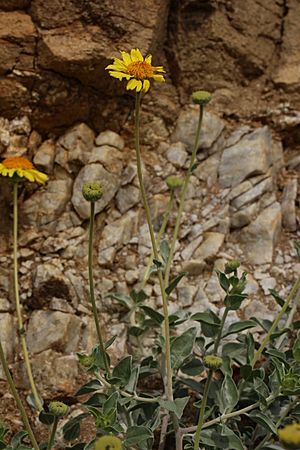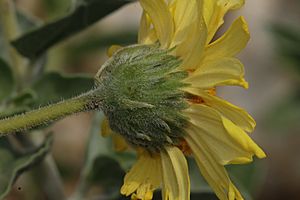Acton brittlebush facts for kids
Quick facts for kids Encelia actoni |
|
|---|---|
 |
|
| Scientific classification | |
| Kingdom: | |
| (unranked): | |
| (unranked): | |
| (unranked): | |
| Order: | |
| Family: | |
| Genus: |
Encelia
|
| Species: |
E. actoni
|
| Binomial name | |
| Encelia actoni Elmer
|
|
| Synonyms | |
|
Encelia virginensis var. actonii; Encelia virginensis ssp. actonii |
|
The Acton brittlebush (scientific name: Encelia actoni) is a beautiful flowering plant. It belongs to the daisy family, also known as Asteraceae. People sometimes call it the Acton encelia. This plant is known for its bright yellow flowers.
Contents
Where the Acton Brittlebush Grows
The Acton brittlebush naturally grows in certain parts of North America. You can find it in southern California and nearby areas of Nevada in the United States. It also grows in Baja California in Mexico.
This plant likes to live in open spaces. It thrives in deserts, chaparral areas, and grasslands. You might see it in the Mojave Desert or the Sonoran Desert. It also grows in mountain ranges like the Peninsular Ranges and Transverse Ranges. Other places include the San Joaquin Valley and the southern Sierra Nevada mountains.
The plant gets its name from a town called Acton in Southern California. This town is special because it's where the desert meets the mountain woodlands.
What the Acton Brittlebush Looks Like
The Acton brittlebush is a shrub that grows many branches. It can reach a height of about 1 to 4 feet (0.3 to 1.2 meters). Its branches are covered with oval or somewhat triangular leaves. These leaves are a few centimeters long. They have a gray-green color and feel woolly or fuzzy.
The plant produces a single flower that looks like a daisy. This flower head is about 1 to 2 inches (2.5 to 5 cm) across. It sits on a tall, straight stem called a peduncle. The center of the flower has many small yellow disc florets. Around these, there can be up to 25 yellow ray florets. The Acton brittlebush usually blooms in the spring.
After blooming, the plant produces a small fruit called an achene. This fruit is about half a centimeter long. It usually does not have a feathery top (called a pappus). The plant is good at spreading its seeds.
Growing the Acton Brittlebush
People often grow the Acton brittlebush in their gardens. It is a great choice for xeriscaping, which means using plants that don't need much water. It's also good for wildlife gardens because it helps local animals. This plant is used in natural landscaping and projects that aim to bring back natural habitats.
The Acton brittlebush needs a lot of sun. After its first summer, it needs very little extra water. It is known as a honey plant because it provides food for many different pollinators, like bees. This plant also has qualities that help slow down wildfires. It doesn't burn easily, which can be helpful in areas prone to fires.
See Also


